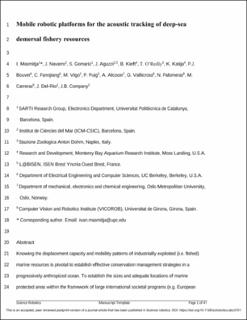Mobile robotic platforms for the acoustic tracking of deep-sea demersal fishery resources
Masmitja, Ivan; Navarro, J.; Gomariz, S.; Aguzzi, J.; Kleft, B.; O'Reilly, T.; Katija, K.; Bouvet, P.J.; Fannjiang, C.; Vigo, M.; Puig, P.; Alcocer, Alex; Vallicrosa, G.; Palomeras, N.; Carreras, M.; Del Rio, J.; Company, J.B.
Journal article, Peer reviewed
Accepted version
Permanent lenke
https://hdl.handle.net/10642/9807Utgivelsesdato
2020-11-25Metadata
Vis full innførselSamlinger
Originalversjon
Masmitja, Navarro, Gomariz, Aguzzi J, Kleft, O'Reilly, Katija, Bouvet, Fannjiang, Vigo, Puig, Alcocer AA, Vallicrosa, Palomeras, Carreras, Del Rio J, Company J. Mobile robotic platforms for the acoustic tracking of deep-sea demersal fishery resources. Science robotics. 2020;5(48) https://doi.org/10.1126/scirobotics.abc3701Sammendrag
Knowing the displacement capacity and mobility patterns of industrially exploited (i.e., fished) marine resources is key to establishing effective conservation management strategies in human-impacted marine ecosystems. Acquiring accurate behavioral information of deep-sea fished ecosystems is necessary to establish the sizes of marine protected areas within the framework of large international societal programs (e.g., European Community H2020, as part of the Blue Growth economic strategy). However, such information is currently scarce, and high-frequency and prolonged data collection is rarely available. Here, we report the implementation of autonomous underwater vehicles and remotely operated vehicles as an aid for acoustic long-baseline localization systems for autonomous tracking of Norway lobster (Nephrops norvegicus), one of the key living resources exploited in European waters. In combination with seafloor moored acoustic receivers, we detected and tracked the movements of 33 tagged lobsters at 400-m depth for more than 3 months. We also identified the best procedures to localize both the acoustic receivers and the tagged lobsters, based on algorithms designed for off-the-shelf acoustic tags identification. Autonomous mobile platforms that deliver data on animal behavior beyond traditional fixed platform capabilities represent an advance for prolonged, in situ monitoring of deep-sea benthic animal behavior at meter spatial scales.
